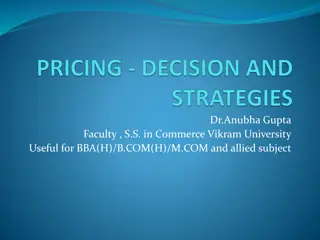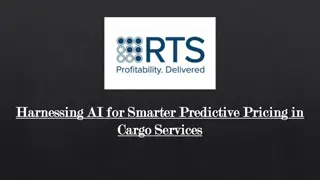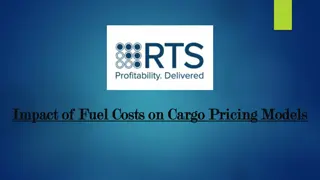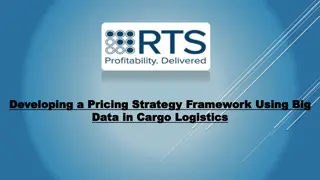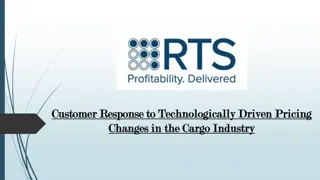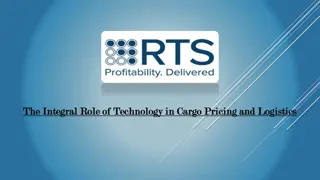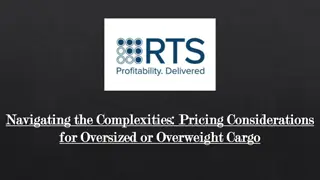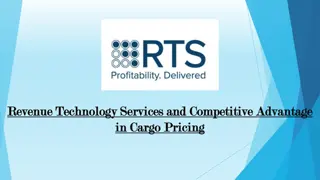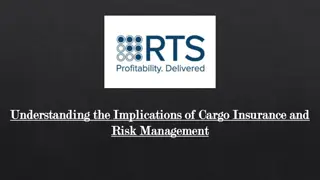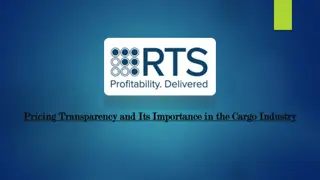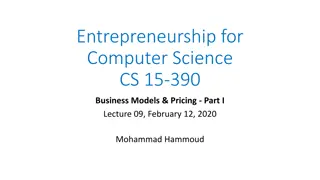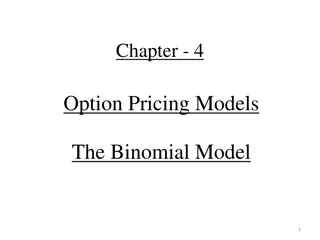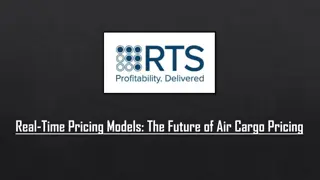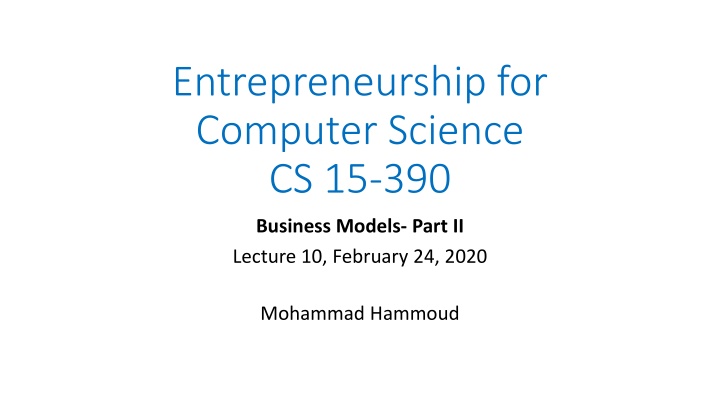
Exploring Business Models in Entrepreneurship for Computer Science - Part II
Dive into various business models such as Freemium, Advertising, Reselling, and Franchise in the context of Entrepreneurship for Computer Science. Understand how each model can be used to monetize products and services effectively, with considerations for sustainable revenue generation and user engagement.
Download Presentation

Please find below an Image/Link to download the presentation.
The content on the website is provided AS IS for your information and personal use only. It may not be sold, licensed, or shared on other websites without obtaining consent from the author. If you encounter any issues during the download, it is possible that the publisher has removed the file from their server.
You are allowed to download the files provided on this website for personal or commercial use, subject to the condition that they are used lawfully. All files are the property of their respective owners.
The content on the website is provided AS IS for your information and personal use only. It may not be sold, licensed, or shared on other websites without obtaining consent from the author.
E N D
Presentation Transcript
Entrepreneurship for Computer Science CS 15-390 Business Models- Part II Lecture 10, February 24, 2020 Mohammad Hammoud
Today Last Session: Business models- Part I Today s Session: Business models- Part II Announcements: Quiz I grades are out PS2 is due on Feb 29 by midnight Midterm is on March 9 during the class time
Outline Business Models- Part III Pricing Framework
The Freemium Model A customer pays zero money for a basic functionality of your product, but pays for obtaining premium features Many people can try your product However, will these people (they are not customers until they pay) pay for the extra features available in your product? Caveat: If people do not pay for your extra features, you do not have a business (recall the solo condition for having a business) Is freemium a business model? Can you not offer premium features and make money through a third party?
The Advertising Model You can make your product free, but monetize your ability to attract and retain a desirable demographic via providing Ads for third parties who want access to them E.g., Google s AdWords Appealing to users and third parties, especially that Ads are seamless (no banners!) and targeted Caveat: many startups have fallen substantially short when they relied solely on Ads
The Reselling Model You can make your product free, but monetize your ability to collect data via reselling data itself orcorresponding analytics to third parties E.g., LinkedIn s recruiters package Transparency is critical! Users should know that some analytics or data about them are being sold to third parties Interestingly, users might use your product just for this specific purpose (e.g., LinkedIn users)
The Franchise Model You can obtain a percentage of sales (dynamic revenue) and/or a large initial startup fee(static revenue)in return of providing your knowledge and permission to use your known brand Expand without investing on the ground! You can also make money via selling your brand-name products to the franchisees to be distributed Quality control might become a concern, but if done rightly, it can improve quality! One study showed that franchisees outperformed their company-owned counterparts by an average of 10% to 30%
The Franchise Model From a franchisor's standpoint, there are four pillars of quality: 1. Franchisee Selection Here is where quality starts! 2. Franchisee Training Not one-time (initially), but rather continuous 3. Ongoing Support This shall span multiple domains, including marketing, public relations, and technology, among others 4. Compliance A franchisor cannot fire a franchisee the way that she/he could fire an employee However, she/he can enforce compliance via a well-crafted contract
A Taxonomy of Business Models: Summary Business Model Business Model Business Model Business Model Business Model Business Model Business Model Description Description Description Description Description Description Description (1) The Up-Front Charge Model A customer pays a large one-time, up-front amount of money to obtain a product/service product/service product/service product/service product/service product/service product/service (1) The Up-Front Charge Model A customer pays a large one-time, up-front amount of money to obtain a (1) The Up-Front Charge Model A customer pays a large one-time, up-front amount of money to obtain a (1) The Up-Front Charge Model A customer pays a large one-time, up-front amount of money to obtain a (1) The Up-Front Charge Model A customer pays a large one-time, up-front amount of money to obtain a (1) The Up-Front Charge Model A customer pays a large one-time, up-front amount of money to obtain a (1) The Up-Front Charge Model A customer pays a large one-time, up-front amount of money to obtain a (2) The Transaction Fee Model (2) The Transaction Fee Model (2) The Transaction Fee Model (2) The Transaction Fee Model (2) The Transaction Fee Model (2) The Transaction Fee Model (2) The Transaction Fee Model A customer pays a commission fee for a referral that leads to a sale A customer pays a commission fee for a referral that leads to a sale A customer pays a commission fee for a referral that leads to a sale A customer pays a commission fee for a referral that leads to a sale A customer pays a commission fee for a referral that leads to a sale A customer pays a commission fee for a referral that leads to a sale A customer pays a commission fee for a referral that leads to a sale (3) The Parking Meter Model (3) The Parking Meter Model (3) The Parking Meter Model (3) The Parking Meter Model (3) The Parking Meter Model (3) The Parking Meter Model (3) The Parking Meter Model A customer pays a small fee for a limited duration and fined high if she/he A customer pays a small fee for a limited duration and fined high if she/he A customer pays a small fee for a limited duration and fined high if she/he A customer pays a small fee for a limited duration and fined high if she/he A customer pays a small fee for a limited duration and fined high if she/he A customer pays a small fee for a limited duration and fined high if she/he A customer pays a small fee for a limited duration and fined high if she/he exceeds that duration exceeds that duration exceeds that duration exceeds that duration exceeds that duration exceeds that duration exceeds that duration (4) The Usage-Based Model (4) The Usage-Based Model (4) The Usage-Based Model (4) The Usage-Based Model (4) The Usage-Based Model (4) The Usage-Based Model (4) The Usage-Based Model A customer pays only for what she/he uses (no base or subscription fee) A customer pays only for what she/he uses (no base or subscription fee) A customer pays only for what she/he uses (no base or subscription fee) A customer pays only for what she/he uses (no base or subscription fee) A customer pays only for what she/he uses (no base or subscription fee) A customer pays only for what she/he uses (no base or subscription fee) A customer pays only for what she/he uses (no base or subscription fee) (5) The Cell Phone Model (5) The Cell Phone Model (5) The Cell Phone Model (5) The Cell Phone Model (5) The Cell Phone Model (5) The Cell Phone Model (5) The Cell Phone Model A customer pays a base fee for a limited amount of usage and high additional A customer pays a base fee for a limited amount of usage and high additional A customer pays a base fee for a limited amount of usage and high additional A customer pays a base fee for a limited amount of usage and high additional A customer pays a base fee for a limited amount of usage and high additional A customer pays a base fee for a limited amount of usage and high additional A customer pays a base fee for a limited amount of usage and high additional usage-based fee for exceeding that amount usage-based fee for exceeding that amount usage-based fee for exceeding that amount usage-based fee for exceeding that amount usage-based fee for exceeding that amount usage-based fee for exceeding that amount usage-based fee for exceeding that amount (6) The Subscription Model (6) The Subscription Model (6) The Subscription Model (6) The Subscription Model (6) The Subscription Model (6) The Subscription Model (6) The Subscription Model A customer pays a subscription fee at the end of every predetermined time period A customer pays a subscription fee at the end of every predetermined time period A customer pays a subscription fee at the end of every predetermined time period A customer pays a subscription fee at the end of every predetermined time period A customer pays a subscription fee at the end of every predetermined time period A customer pays a subscription fee at the end of every predetermined time period A customer pays a subscription fee at the end of every predetermined time period (7) The Licensing Model (7) The Licensing Model (7) The Licensing Model (7) The Licensing Model (7) The Licensing Model (7) The Licensing Model (7) The Licensing Model A seller licenses her/his product (or strong IP) to a business and receives in return a royalty on sales or a regular fixed amount of money a royalty on sales or a regular fixed amount of money a royalty on sales or a regular fixed amount of money a royalty on sales or a regular fixed amount of money a royalty on sales or a regular fixed amount of money a royalty on sales or a regular fixed amount of money a royalty on sales or a regular fixed amount of money A seller licenses her/his product (or strong IP) to a business and receives in return A seller licenses her/his product (or strong IP) to a business and receives in return A seller licenses her/his product (or strong IP) to a business and receives in return A seller licenses her/his product (or strong IP) to a business and receives in return A seller licenses her/his product (or strong IP) to a business and receives in return A seller licenses her/his product (or strong IP) to a business and receives in return
A Taxonomy of Business Models: Summary Business Model Business Model Business Model Business Model Business Model Business Model Description Description Description Description Description Description (8) The Consumable Model (8) The Consumable Model (8) The Consumable Model (8) The Consumable Model (8) The Consumable Model (8) The Consumable Model A customer pays an up-front amount of money for a product, but also pays ongoing A customer pays an up-front amount of money for a product, but also pays ongoing A customer pays an up-front amount of money for a product, but also pays ongoing A customer pays an up-front amount of money for a product, but also pays ongoing A customer pays an up-front amount of money for a product, but also pays ongoing A customer pays an up-front amount of money for a product, but also pays ongoing fees while using it fees while using it fees while using it fees while using it fees while using it fees while using it (9) The Upsell Model (9) The Upsell Model (9) The Upsell Model (9) The Upsell Model (9) The Upsell Model (9) The Upsell Model A customer pays low-margin fee for a product and high-margin fee for A customer pays low-margin fee for a product and high-margin fee for A customer pays low-margin fee for a product and high-margin fee for A customer pays low-margin fee for a product and high-margin fee for A customer pays low-margin fee for a product and high-margin fee for A customer pays low-margin fee for a product and high-margin fee for corresponding add-on products corresponding add-on products corresponding add-on products corresponding add-on products corresponding add-on products corresponding add-on products (10) The Freemium Model (10) The Freemium Model (10) The Freemium Model (10) The Freemium Model (10) The Freemium Model (10) The Freemium Model A customer pays zero money for a basic functionality of a product, but high fee for A customer pays zero money for a basic functionality of a product, but high fee for A customer pays zero money for a basic functionality of a product, but high fee for A customer pays zero money for a basic functionality of a product, but high fee for A customer pays zero money for a basic functionality of a product, but high fee for A customer pays zero money for a basic functionality of a product, but high fee for obtaining its premium features obtaining its premium features obtaining its premium features obtaining its premium features obtaining its premium features obtaining its premium features (11) The Advertising Model (11) The Advertising Model (11) The Advertising Model (11) The Advertising Model (11) The Advertising Model (11) The Advertising Model A customer (typically a third party) pays for having Ads directed and shown for a A customer (typically a third party) pays for having Ads directed and shown for a A customer (typically a third party) pays for having Ads directed and shown for a A customer (typically a third party) pays for having Ads directed and shown for a A customer (typically a third party) pays for having Ads directed and shown for a A customer (typically a third party) pays for having Ads directed and shown for a desirable demographic (or what is referred to as targeted Ads) desirable demographic (or what is referred to as targeted Ads) desirable demographic (or what is referred to as targeted Ads) desirable demographic (or what is referred to as targeted Ads) desirable demographic (or what is referred to as targeted Ads) desirable demographic (or what is referred to as targeted Ads) (12) The Reselling Model (12) The Reselling Model (12) The Reselling Model (12) The Reselling Model (12) The Reselling Model (12) The Reselling Model A customer pays for obtaining analytics/reports generated from user data A customer pays for obtaining analytics/reports generated from user data A customer pays for obtaining analytics/reports generated from user data A customer pays for obtaining analytics/reports generated from user data A customer pays for obtaining analytics/reports generated from user data A customer pays for obtaining analytics/reports generated from user data (13) The Franchise Model (13) The Franchise Model (13) The Franchise Model (13) The Franchise Model (13) The Franchise Model (13) The Franchise Model A customer pays a percentage of sales and/or a (large) initial startup fee in return of A customer pays a percentage of sales and/or a (large) initial startup fee in return of A customer pays a percentage of sales and/or a (large) initial startup fee in return of A customer pays a percentage of sales and/or a (large) initial startup fee in return of A customer pays a percentage of sales and/or a (large) initial startup fee in return of A customer pays a percentage of sales and/or a (large) initial startup fee in return of obtaining a permission to use a known brand obtaining a permission to use a known brand obtaining a permission to use a known brand obtaining a permission to use a known brand obtaining a permission to use a known brand obtaining a permission to use a known brand
Outline Business Models- Part III Pricing Framework
Pricing Framework A price that is 1% higher, leads to an 11% increase in overall profits ( The 1% Windfall by Rafi Mohammed) Fine-tuning your pricing strategy can have a huge impact on your earnings! PRICE PROFITS Improving pricing can have a big effect on profits but be patient until the market matures and you have enough info
Pricing Framework Pricing is set based on your business model Business model is static (i.e., it rarely changes) Pricing framework is dynamic Some businesses change pricing on a daily basis (e.g., gas stations) Some businesses even change pricing on a real-time basis (e.g., airline tickets) Getting pricing right is an iterative and ongoing process! Start at some point that is the best guess for the moment, then spiral closer and closer to a better answer Objective: strike a balance between maximizing revenue and maximizing customer base
Basic Pricing Concepts 1. Do not use cost as a factor in deciding the price of your product Set your price based on the value that the customer gets from your product (which stems from your business model) E.g., a subscription model allows pricing higher than an up-front charge model Cost-based strategies almost always leave money on the table In software, the marginal cost (the cost of producing one more copy of the software) is almost zero; hence, pricing based on cost would make it difficult to make any money My business is very simple. My customers give me $2 and they get back $10. That is why we are so successful by Steve Walske
Basic Pricing Concepts 2. Use the Decision-Making Unit (DMU) and the process to acquire a paying customer as a way to identify key price points Example: Kinova Robotics Business Branch: Selling Jaco assistive robotic arm One Market: Netherlands Primary Market Research: End-users: disabled people on wheelchairs Economic-buyers: mainly health insurance companies, which reimburse up to only 28,000 euros Decided Pricing: 28,000 euros Results: Sales cycle length & Cost of Customer Acquisition (COCA) were dramatically decreased, which allowed Kinova to quickly ramp up sales and enjoy a large market share
Basic Pricing Concepts 3. Understand the prices of your customer s alternatives Are there alternative products available? If so, how much the customer would pay for each? What distinguishes your product from the available alternatives? It might be better NOT to set the price of your product higher (not even initially!) than alternatives, although it might be more advanced 4. It is always easier to drop rather than raise the price It is best to price high and offer discounts initially, rather than price too low and raise later In Reality: each left segment in the technology adoption life cycle is willing to pay more than its neighboring right segment
Basic Pricing Concepts LATE MAJORITY conservatives The Technology Adoption Life Cycle THE CHASM Different types of customers will pay different prices! INNOVATORS techies LAGGARDS skeptics EARLY MAJORITY pragmatists EARLY ADOPTERS visionaries
Basic Pricing Concepts 5. Be flexible with pricing for early adopters and lighthouse customers On one hand, these customers can help you cross the chasm! On the other hand, you do not want your early one-time-only deals to define your general pricing strategy Options: Offer them discounts on up-front charges, or free or low-cost trial period; but have them sign an agreement where their pricing terms be kept confidential
Summary Pricing is primarily about determining how much value your customer gets from your product and, accordingly, capturing a fraction of that value back for your business You can charge higher price to early customers as opposed to later customers, but be flexible in offering special, one-time-only discounts to early testers and lighthouse customers Unlike your business model, pricing will continually change (e.g., in response to market conditions)
Next Class Calculate the Lifetime Value (LTV) of an Acquired Customer

